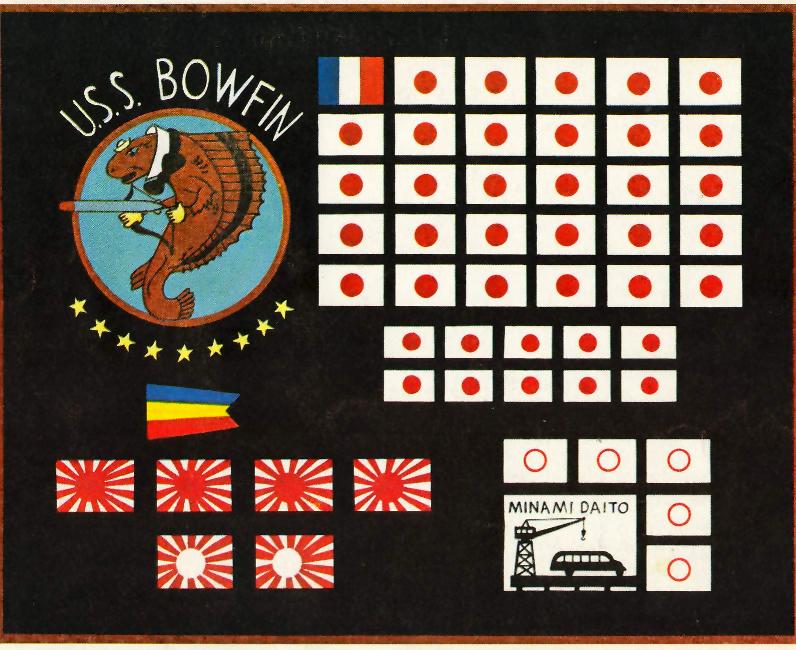
Travel information
The entry fee for the museum is $15 per person. From the Honolulu Waikiki Beach hotel, it is about 13 miles away, which is 1.25-1.5 hours away by bus. The price varies from $2 to $5 per person, but would most likely be around $5. The fast way would be to take the bus stop at the corner of Kuhio and Paoakalani Avenues.
History of the USS Bowfin
The USS Bowfin (SS/AGSS-287) was Balao-class attack submarine that was part of the US Navy’s Pacific Fleet in World War II. It was nicknamed “the Pearl Harbor Avenger,” because it was launched on the first anniversary of the Pearl Harbor attack. Between the years 1943 and 1945, the submarine conducted nine war patrols, most of which were in the vicinity of Japan, either in the Pacific Ocean or the Sea of Japan. The submarine sank over 34 large vessels, ranking it 15th in number of ships sunk among commissioned Allied submarines.
Two battle flags were made during the war by the crew of the submarine, which symbolized the success of its nine war patrols. Two more flags were made after the war, one of which represents the awards that the submarine received during WWII.

Her name was stricken from the official Navy list of active ships on 1 December 1971. She was taken back to Pearl Harbor in the aftermath and was developed into a museum in 1981. The Bowfin was declared a National Historic Landmark in 1986 and has been used as sets in both television programs and films.

Cultural significance
The museum has a Waterfront Memorial dedicated to the submarines and servicemen lost during World War II. The memorial itself is set up like a circle, with information on plaques surrounding a US flag. The submarines mentioned (and honored) are seen in photographs and physical displays, along with other historical objects. Seeing these objects in context can help shape tourists’ memories not just of Hawaii and the USS Bowfin but the entirety of the Pacific Theater. Sites like these reinforce Pierre Nora’s ideas about sites and memories while also demonstrating how collective and individual memories are constantly challenged and shaped by the world around us.

The Bowfin Museum creates memories of World War II by keeping the real submarine historically intact. Tourists site can semi-experience the day-to-day life of crew members; they can see where they slept, where they ate, and where they worked all while bathing in an atmosphere of fear. One of the primary effects is the feeling of confinement/claustrophobia within the vessel. There is not a lot of space to move around, which demonstrates how all of the sailors had to work together to achieve their goals.
National identity can also play a part in how the tourists receive and interpret the site. Emily S. Rosenberg’s A Date Which Will Live: Pearl Harbor in American Memory (2003) shows how American have debated Pearl Harbor’s historical meaning more or less constantly since 1941. It has been a shorthand for revenge, for national guilt, for recalling a wartime spirit, and many other meaning. Whenever a visitor enters Bowfin Park, they bring their own cultural knowledge and collective memories with them. For example, the battle flags signal a successful mission to an American while provoking an entirely different feeling in a Japanese visitor. Location is important: one doesn’t visit Pearl Harbor without some knowledge of what happened there in 1941. But objects are important, too. And that doesn’t just mean the physically present objects but also the things that aren’t there.
Drozdzewski, Waterson, and Sumartojo (2019) expand on the relationship between location and war memory. For example, being at the location of an important historical event gives a first-hand experience and allows the viewer to have an easier time imagining the past events. This can make a memory or an educational experience feel more real. Tourists enter Bowfin Park and walk the same areas that sailors did in the 1940s. Pearl Harbor “offers a clear illustration of the way an object of war can, and often does, become an object of memory, not only because it has a resilient gravitational pull and affective intensity, but because it is also used to define the meaning of other objects and events in its vicinity.” (Drozdzewski, Waterson, and Sumartojo, 2019). In Pearl Harbor’s case, people remain drawn to it despite the distance of time because it keeps resurfacing in the popular memory through films like Michael Bay’s Pearl Harbor (2001) or, even worse, events like the 9/11 terror attacks. The point is that these memories are constantly contested and changed even if the sites of memories, to use Nora’s term, are relatively static.
References
- Chavarro, J. (2014). USS Bowfin Submarine Museum at Joint Base Pearl Harbor-Hickam. [Digital image]. Wikimedia Foundation. https://commons.wikimedia.org/wiki/File:USS_Bowfin_Submarine_Museum_at_Joint_Base_Pearl_Harbor-Hickam.JPG
- Drozdzewski, D., Waterton, E., and Sumartojo, S. (2019). Cultural memory and identity in the context of war: Experiential, place-based, and political concerns. International Review of the Red Cross 101, no. 1: 251-272. Retrieved 13 February 2020. DOI: 10.1017/s18163831.19000110
- Keith, D. (2006). Final patrol: True stories of World War II submarines. Boston, Mass.: Dutton Caliber.
- Messerly, J.J. (2012). 40mm/56 Bofors Mark 2 Quad Anti-Aircraft Mount at USS Bowfin Submarine Museum and Park, Pearl Harbor, Hawaii. [Digital image]. Wikimedia Foundation. https://commons.wikimedia.org/w/index.php?curid=18750200
- Nandaro. (2008). USS Bowfin Submarine Museum and Park,[Digital image]. Wikimedia Foundation. https://commons.wikimedia.org/w/index.php?curid=29461483
- Rosenberg, Emily S. (2003). A date which will live: Pearl Harbor in American memory. Durham, N.C.: Duke University Press.
- Seaton, P.A. (2007). Japan’s contested war memories: The ‘memory rifts’ in historical consciousness of World War II. London: Routledge.
- Suzuki, T. (2016). Bridging between “here/now” and “there/then”: guiding Japanese mainland school “peace education” tours in Okinawa. Journal of Cultural Geography 33, no. 1: 100–125. https://doi.org/10.1080/08873631.2015.1065032
- USS Bowfin Submarine Museum & Park. (2016). Retrieved May 10, 2020, from http://pearlharbor75thanniversary.com/uss-bowfin-submarine-museum-park/
- USS Bowfin. (2020). Retrieved May 10, 2020, from https://www.bowfin.org/